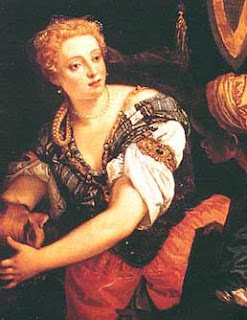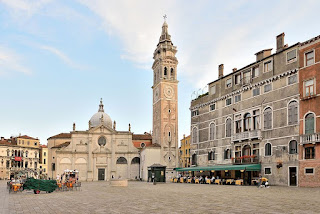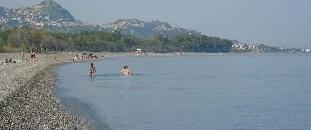The literary talent of a popular prostitute
 |
| Veronica Franco was in her lifetime one of the most famous courtesans in Venice |
A cortigiana onesta, literally 'honest courtesan', but really meaning intellectual and high class, Veronica is remembered for the quality of her poetry as well as her profession.
In the 16th century Venice was renowned for the number of its courtesans and Veronica became one of the most famous of them.
She had three brothers who were educated by tutors and fortunately her mother, a former cortigiana onesta herself, had ensured that Veronica shared that education.
Veronica was married in her mid teens to a physician, but she soon initiated divorce proceedings. She asked her husband to return her dowry but he refused, and with a young child to support, she had no choice but to become a courtesan.
She was a great success and was able to support her family well for the next few years. By the time she was 20, Veronica was among the most popular and respected courtesans in Venice.
Among her clients were King Henry III of France and Domenico Venier, a wealthy poet whose salon she joined.
 |
| Franco was sponsored by the wealthy poet and socialite Domenico Venier |
In 1575 she published Terze Rime, a collection of 25 verse letters, of which 17 had been written by her.
Veronica’s poetry was sexually explicit. She was not ashamed of being a courtesan and she defended the rights of courtesans and women generally in several of the poems.
Soon after her book was published, a bout of plague broke out in Venice that was to last for two years. Veronica was forced to flee the city and while she was away her house was looted and she lost most of her possessions. She was saved from ruin only by the generosity of her client, Domenico Venier.
The plague had killed her mother and one of her brothers so Veronica was left with the care of her nephews as well as her own three children. She unsuccessfully tried to persuade Venice to fund a charity for the children of courtesans.
In 1577, her son’s tutor denounced her to the Inquisition on a charge of witchcraft, a common complaint lodged against courtesans at the time.
She defended herself eloquently and, helped by her many clients among the nobility, managed to win an acquittal. But by then she had lost most of her money and she had to move to a poor area of the city.
In 1580, Veronica published a collection of 50 letters she had written to her clients and friends. Little is known about her life after that time and she died at the age of 45 in poverty.
Her life was the subject of a book, The Honest Courtesan, by US author Margaret Rosenthal, which was published in 1992. The 1998 film, Dangerous Beauty, was based on the book.
 |
| Franco was sponsored by the wealthy poet and socialite Domenico Venier |
Many of Venice’s 16th century prostitutes, which at one time amounted to a fifth of the city’s female population, did their business in an area of the San Polo sestiere known as Carampane, not far from the Rialto bridge. The name derives from a particularly infamous brothel called Palazzo Ca’ Rampani. Today, visitors to Venice can stroll down Rio Terra de la Carampane towards San Cassiano and cross the Ponte delle Tette - Bridge of Tits - where prostitutes used to gather to advertise their services. The nearby Trattoria Antiche Carampane, a highly regarded restaurant known for its seafood.
Venice hotels by Booking.com
 |
| The west face of the church of Santa Maria Formosa, which was frequented by Franco as a girl |
Ca’ Venier, the house where Veronica Franco’s patron, Domenico Venier, held his literary salons and where Veronica read and circulated most of her poems, was in Campo Santa Maria Formosa in the Castello sestiere, which is also known to have been Franco’s home parish. Ca’ Venier can be found adjoining the popular Hotel Scandinavia, opposite the church of Santa Maria Formosa, which was built at the end of the 15th century and completed by the middle of the next century.


















